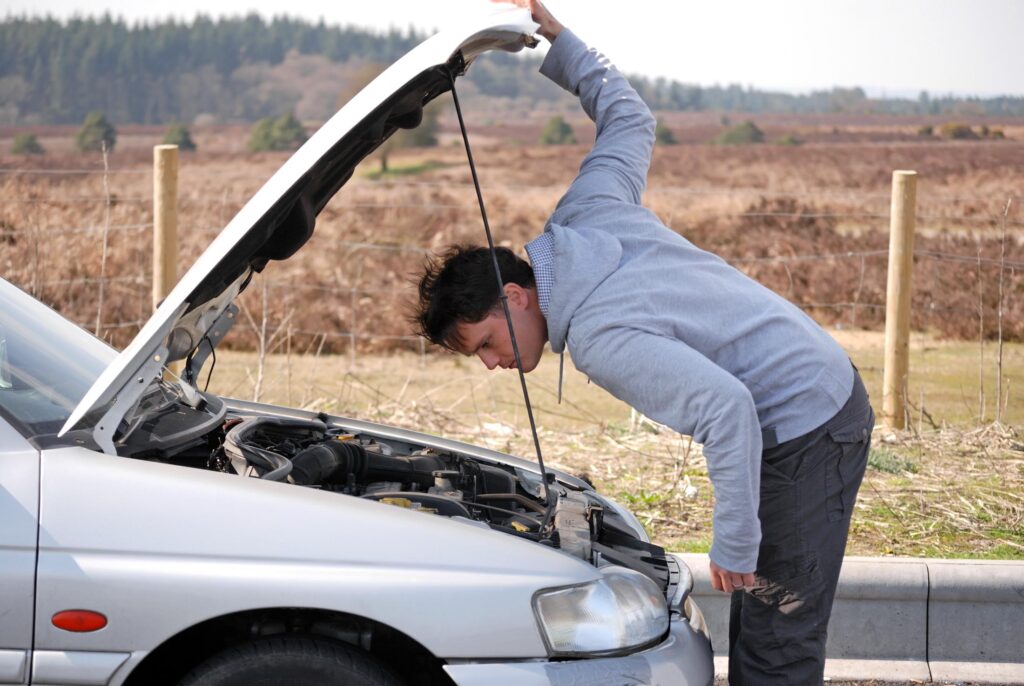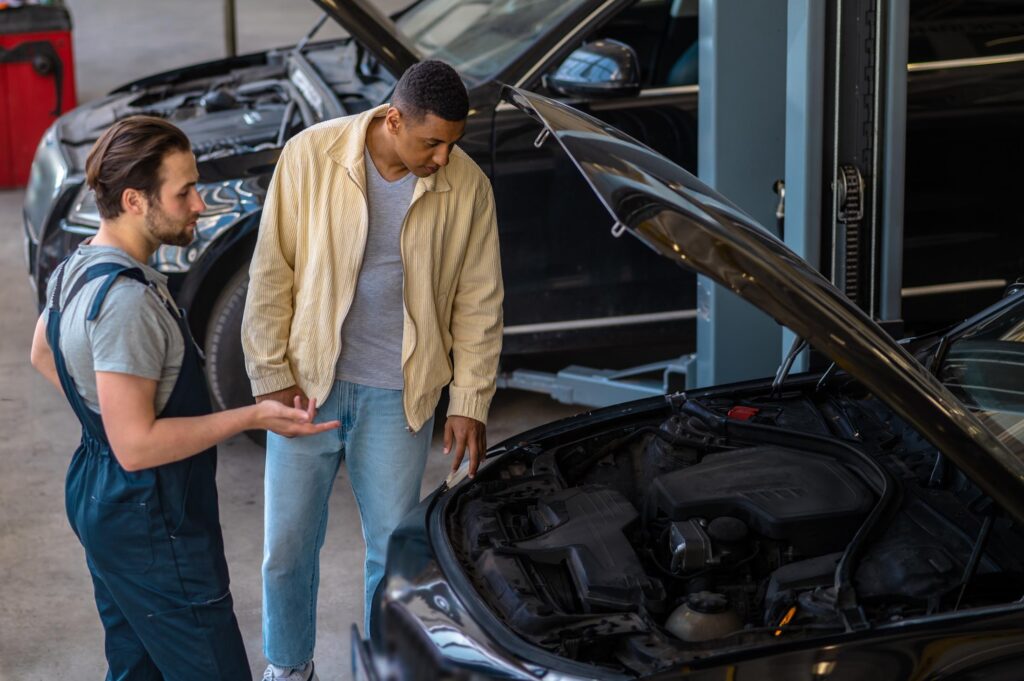What Is a Hydrolocked Engine? Symptoms Causes and FAQs
Poor driving habits often lead to vehicle problems, such as engine malfunctions and faulty components. This applies to different practices, even ones that seem harmless, like driving over potholes or water. One potential effect of such habits is hydrolock.
What Is Hydrolock?
Hydrolock is when an engine has too much water in its cylinders. It causes the pistons and other components to seize, leading to mechanical failure or power shortage.
Hydrolock Symptoms
A hydrolocked engine exhibits different symptoms based on the severity of the damage and the amount of water in the pistons. Most of them involve the engine, as its the component most affected by the excess water.
Engine Stalling

Engine stalling happens when the engine turning suddenly stops. Hydrolock can cause it, as the excess water that gets in the chamber affects the ratio of the air and fuel in the vehicle, decreasing the power of the engine.
Engine Doesn’t Turn Over
Engine turn over is the process of starting your vehicle. It’s when the battery sends an electrical pulse to the spark plugs that cause the ignition to start the engine.
A hydrolocked engine may soak the spark plugs, which leads to the lack of electricity needed to ignite the engine.
Crashing Sounds
The crashing noise you hear when the engine is hydrolocked is due to the water filling the cylinders. It’s often followed by the engine shutting off, then a loud thud. It occurs when water gets into the cylinder, leaving no space for fuel combustion.
Effects of Hydrolock
Besides engine stalling, hydrolock can damage other car components. The severity of the damage depends on the amount of water that got into the system. An excessive amount could leave some parts malfunctioning.
Broken Connecting Rod
The connecting rod or con rod is a part of the engine that connects the piston to the crankshaft. A hydrolocked engine may cause the connecting rod to bend or break, especially if the engine is powerful enough to handle large amounts of water.
A broken connecting rod could also lead to permanent engine damage, as it blows holes through the cylinder head.
Damaged Crankshaft
The crankshaft is essential for engine operation, as it causes linear motion to rotate. Simply put, it converts heat into energy that allows your vehicle to function.

If the connecting rod breaks due to the hydrolock, it can also affect the crankshaft, as it only moves upward. The force of the sudden stop may crack the crankcase, which exposes the shaft. Similarly, hydrolock may also damage the engine bearings.
What Causes Hydrolock?
Excess fluid causes hydrolock, and there are different ways it can get into your engine:
Driving Through Water
Driving through high water could cause it to kick up through the intake. The water soaks into the air filter and the inlet manifold.
The intake removes excess water, but a large amount is too much for it to handle. And as you drive through water, the water in the engine flows into the cylinder until the piston can no longer handle it.
Vehicle Modifications
Some modifications to the intake system put it in a compromising position, making it easier for water to get through the corner of the bumper.
Head Gasket Failure
The head gasket seals the engine’s combustion chamber, allowing your car to build the compression needed to maintain engine power. It also keeps coolant and oil from leaking, which prevents overheating engines.
A damaged or faulty head gasket could lead to hydrolocking, as the coolant can leak into the pistons. One of the most common causes of gasket failure is accelerated thermal expansion.
Injector Leak
The fuel injector pushes fuel into the internal combustion engine. As such, a cracked injector can lead to fuel flooding within the engine.
Ways to Prevent Hydrolock

Luckily, hydrolock is preventable if you take the proper precautionary steps. Here are some ways you can protect your engine from excess liquid:
Avoid High Water
Driving through flood or any form of high water is the leading cause of hydrolocks. If you find yourself staring down water, slow down and consider if it’s safe to drive through it. Find a different route or carefully drive through the water to prevent getting excess moisture in your engine.
Don’t Park Outside During Heavy Rain
Similarly, avoid parking outside during heavy rain or storms, as they can cause floods. Even if it doesn’t flood, water may naturally seep into the engine.
Avoid Jetting Water Into the Air Filter
If you’re washing your vehicle, don’t spray water near the air filter. Due to the filter’s structure and location, any form of liquid near the area will find its way into the engine and other important components.
Take Your Vehicle to Mechanics for Regular Maintenance
If the engine is on the verge of hydrolocking, experts can easily detect and prevent it from happening. Additionally, the mechanics can also prevent further damage if the engine is already hydrolocked.
How Do Mechanics Fix Hydrolock?
Fixing a hydrolocked engine involves draining the water that seeped into the engine. Here is what you can expect when you have your hydrolocked vehicle repaired:
- Step 1: The water or fluid inside the engine cylinders is drained.
- Step 2: The engine is dismantled and separated from other components.
- Step 3: Engine-related components, such as the bearing, pistons, and cylinders, are inspected.
- Step 4: Faulty parts are replaced.
- Step 5: The vehicle is reassembled and tested to check if the engine is running smoothly.
How Much Does It Cost to Fix Hydrolock?
The price of fixing a hydrolocked engine is quite steep, ranging from $3,000 to $8,000. The final bill depends on the severity of the damage to the engine and other components.
The post What Is a Hydrolocked Engine? Symptoms, Causes, and FAQs appeared first on In The Garage with CarParts.com.
https://ift.tt/uB9GotZ https://ift.tt/eqc9Z5H https://notes.io//Tzb4 https://ift.tt/VF3OZxq https://ift.tt/AkHlU81 https://ift.tt/lGUfhEo https://ift.tt/xcd3L17 https://ift.tt/HCwneo6 https://ift.tt/7VGLOyH https://ift.tt/pTJb9GU https://ift.tt/sh3ytkG https://ift.tt/7s8eBGW https://ift.tt/fCBh149 https://ift.tt/yl6RCxB https://notes.io//Tzxx https://ift.tt/0cnbTlB https://ift.tt/KhPDyu1 https://ift.tt/qSZXvuU https://ift.tt/2CqmEBP https://ift.tt/21xyosz https://ift.tt/n4b30iF https://ift.tt/sRQiZ1t https://ift.tt/gYuA9vm https://ift.tt/0UV3FLq https://ift.tt/s6ugaUL https://ift.tt/81sUAmS https://ift.tt/3J5Erld https://notes.io//TzdJ https://ift.tt/Z2u0plE https://ift.tt/fAYH4wi https://ift.tt/NjOeX5G https://ift.tt/s3BYeUd https://ift.tt/b2TdSiL https://ift.tt/EFCxseH https://ift.tt/8gv7TOz https://ift.tt/cdVqmuj https://ift.tt/uTbgk1R https://ift.tt/VBNnf9d https://ift.tt/E6NpvlW https://ift.tt/kqtYLpP https://ift.tt/TutPYyG https://notes.io//Tzdn https://ift.tt/HJsKfgV https://ift.tt/BZOXj36 https://ift.tt/t68LwSo https://ift.tt/ef7Q83a https://ift.tt/yl36gR9 https://ift.tt/KnjCsEk https://ift.tt/wQyM9on https://ift.tt/mdNV3At https://ift.tt/EdvUQst https://ift.tt/4KVIyAB https://ift.tt/eREtUI4 https://ift.tt/i8nob9A https://ift.tt/vQLuXDr https://notes.io//Tzdm https://ift.tt/AB6yv3H https://ift.tt/lMw5a9Y https://ift.tt/t68LwSo https://ift.tt/GrJ1abw https://ift.tt/digz0ps https://ift.tt/SzNQ5G6 https://ift.tt/3ekLbS8 https://ift.tt/f0FTUIc https://ift.tt/jhyQHdE https://ift.tt/7C4w6g9 https://ift.tt/zM3QNAL https://ift.tt/YNfjBuA https://ift.tt/03VCsjQ https://notes.io//TzxT https://ift.tt/4m1gTho https://ift.tt/2tW7JyF https://ift.tt/JtFM30m https://ift.tt/MiWjNws https://ift.tt/vzdwq46 https://ift.tt/UbV43EB https://ift.tt/VAb7lBW https://ift.tt/9iRtnZA https://ift.tt/UqgGJp7 https://ift.tt/dUecKHx https://ift.tt/3D9iCgv https://ift.tt/Ldb5UYO https://ift.tt/OFzCrxN https://notes.io//TzhL https://ift.tt/Z6pvljD https://ift.tt/j4nWlAr https://ift.tt/zISsCRZ https://ift.tt/395etxm https://ift.tt/OMWS4NC https://ift.tt/oBKFfP5 https://ift.tt/zwj3fQL https://ift.tt/pe5WERv https://ift.tt/k5AUday https://ift.tt/HqSjfB2 https://ift.tt/wiY3mSI https://notes.io//Tzdb https://ift.tt/AMr1Di0 https://ift.tt/Kq2u6Nx https://ift.tt/ZeNPnKQ https://ift.tt/ImiEVp1 https://ift.tt/WJxBfpI https://ift.tt/7t4DFw1 https://ift.tt/0TjMWsh https://ift.tt/sM9KWrm https://ift.tt/b7f85OW https://ift.tt/PmDV5e6 https://ift.tt/Qx9PmFZ https://ift.tt/ZURK6qb https://ift.tt/mOp3DtT https://notes.io//TzsQ https://ift.tt/SGNPik1 https://ift.tt/v5xQCoa https://ift.tt/EJTgKLb https://ift.tt/QU1RFNa https://ift.tt/AD09owu https://ift.tt/unxk2BA https://ift.tt/c6HmNyr https://ift.tt/5sA9jew https://ift.tt/yJ4rgv8 https://ift.tt/Lit0Z6q https://ift.tt/apAuQVo https://ift.tt/boRqkIn https://ift.tt/hqmNR20 https://notes.io//Tzdq https://ift.tt/isJFWhu https://ift.tt/1WuoOX3 https://ift.tt/pegDM4d https://ift.tt/rx8IwSR https://ift.tt/YIfxFQ3 https://ift.tt/gGcPaqb https://ift.tt/30MVNIL https://ift.tt/aCfnkev https://ift.tt/FRautDO https://ift.tt/IR3ljzE https://ift.tt/FMjGfyc https://ift.tt/CY1nsmP https://ift.tt/YQMBJb2 https://notes.io//Tzja https://ift.tt/IOG524X https://ift.tt/SHecOTL https://ift.tt/qwdsTBc https://ift.tt/D5cTCIg https://ift.tt/4UsFN90 https://ift.tt/EPlX2HV https://ift.tt/6fWGNAh https://ift.tt/khiUpOF https://ift.tt/gHY0w6e https://ift.tt/LEFsfC0 https://ift.tt/7O59GyN https://ift.tt/XpkuYoB https://ift.tt/LRrAwaM https://notes.io//TzdH https://ift.tt/F6jbE7U https://ift.tt/XPBuyVv https://ift.tt/xWjh1qQ https://ift.tt/S0jyrb2 https://ift.tt/Icq52ho https://ift.tt/DfP51Rx https://ift.tt/GEaStxW https://ift.tt/SAYNdiR https://ift.tt/gaRHJyA https://ift.tt/10UG4TE https://ift.tt/rUw15DH https://ift.tt/XOgk8H9 https://notes.io//TzpE https://ift.tt/Xs2ivVz https://ift.tt/BfPANca https://ift.tt/M5RZ0zS https://ift.tt/FY6cHPv https://ift.tt/iHlPrxL https://ift.tt/s32JQGi https://ift.tt/ELzOPYs https://ift.tt/GlIbMeP https://ift.tt/vEwMn01 https://ift.tt/VCZqaUt https://ift.tt/oUPFunX https://ift.tt/PSgdXuU https://ift.tt/lTeYzdo https://notes.io//TzpN https://ift.tt/ZOMSj91 https://ift.tt/QxYIqXH https://ift.tt/Ihr6BYm https://ift.tt/VQqBwoz https://ift.tt/G7T05sH https://ift.tt/6qYf2PZ https://ift.tt/emMh3Gd https://ift.tt/EyHcXun https://ift.tt/4bzAted https://ift.tt/lCBJLyV https://ift.tt/wOcFLtD https://ift.tt/RWfp5rl https://ift.tt/SwrIEO3 https://notes.io//Tzsb https://ift.tt/TmZiloY https://ift.tt/V2iQs91 https://ift.tt/S43YmGl https://ift.tt/C3rKaQL https://ift.tt/TyUQWSb https://ift.tt/pALjcnr https://ift.tt/4KinU9C https://ift.tt/ipV0EQC https://ift.tt/U7rENxt https://ift.tt/dbp5X1z https://ift.tt/Qvu9Nio https://ift.tt/hUPmcRA https://ift.tt/MdkTZ0G https://notes.io//Tzat https://ift.tt/JCwqM6P https://ift.tt/b0IEc3y https://ift.tt/ORYQrPF https://ift.tt/sgDGS9L https://ift.tt/LrlSGOq https://ift.tt/pE2bnC9 https://ift.tt/EpfARra https://ift.tt/8Yq4P7V https://ift.tt/7JOfRqr https://ift.tt/ewTX5Rq https://ift.tt/pjXZ5KH https://ift.tt/4Lcx5CA https://ift.tt/Hxh9CAK https://notes.io//TzpW https://ift.tt/DYMQ7Vi https://ift.tt/gdAUNBr https://ift.tt/cwZ7NsL https://ift.tt/FY6cHPv https://ift.tt/CvpAFrm https://ift.tt/Std4Bcq https://ift.tt/2ypIkfH https://ift.tt/MJ0WyTC https://ift.tt/A8nS9Ct https://ift.tt/WQPfcjl https://ift.tt/T3YMemo
Comments
Post a Comment